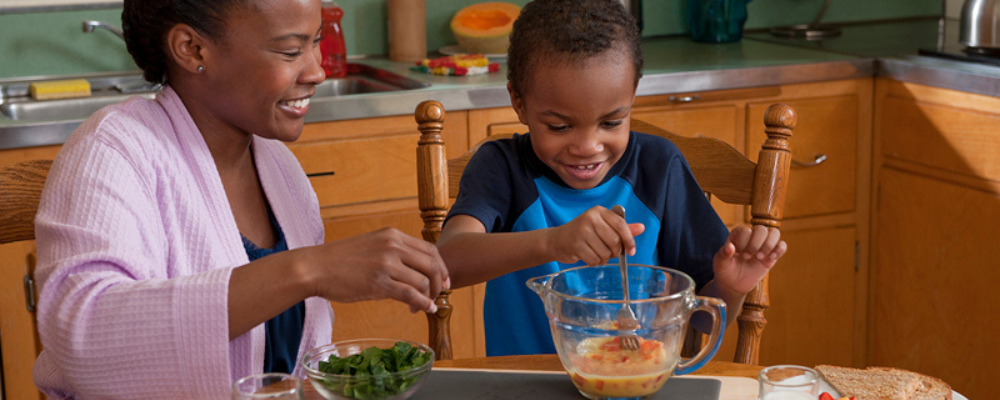
5 Tips for Quick and Healthy Back to School Dinners
— By Kate Yerxa, MS, RD, Extension Professor, University of Maine Cooperative Extension
School is back in session and for a lot of families that means after school activities and busy evenings, leaving little time for making dinner. To help make evening meals a little less stressful, here is a list of our top 5 tips to help you navigate those evenings and help you get quick and healthful meals on the table.
Tip #1: Plan your meals.
Set aside time to create a menu of meals for the week. Meals can include your family’s favorite recipes and meals that use foods you have on hand (check your freezer and pantry) and include leftovers as meals. Try using Make Your Own: A Recipe Guide for meal ideas that use leftovers and meal ingredients you have on hand. Don’t forget to take into account the after school or evening activities that are happening when planning meals.
Tip #2: Prepare meals and meal ingredients ahead of time.
Using your meal plan, streamline your cooking process by prepping ingredients in advance. Chop and/or roast vegetables, cook meat, and cook grains ahead of time. Preparing ingredients ahead of time is a great way to get children involved in the kitchen and help them learn cooking skills. It may take some extra time at first, but as children are given more opportunities to practice these skills, they will become more confident and able to help more with the meal planning and preparation process.
Frozen meals can make for a quick meal on busy weeknights – so make your own and save money. You can freeze meals in single serve portions or make and freeze a full recipe such as casseroles, soups and stews, and baked pasta dishes. When freezing meals, make sure to use freezer grade storage containers and use the meals within three months of freezing for best quality. Labels meals with the name of the meal, the date it was frozen, and the cooking instructions.
Tip #3: Add one-dish meals into your weekly meal plan.
One-dish meals are a great way to save time and dishes on busy weeknights. A few ideas for one-dish meal ideas include:
Sheet pan dinners:
To make a sheet pan meal, mix protein, vegetables, seasoning, and vegetable oil onto a sheet pan and roast at 375 degrees F for 45 – 55 minutes or until the protein is cooked to the safe internal temperature. If you are unsure of the correct temperature to cook food to, USDA has developed a Safe Internal Temperature Chart you can use.
Casseroles and pasta dishes:
Pasta dishes are a great weeknight meal. One-pot pasta dishes can be made quickly, and casseroles can be made ahead of time. My favorite one-pot pasta dish is Pasta with Garlic, Spinach, and White Beans and my go-to casserole is Cheesy Lentils and Rice.
Slow cooker meals:
Slow cooker meals are perfect for those nights when you need to come home and have dinner ready to eat. My family’s favorite slow cooker soup is the Winter and Black Bean Soup.
Tip #4: Dinner doesn’t have to be fancy!
Breakfast for dinner, soup and sandwiches, or boxed macaroni and cheese can all make a healthy, fast meal. Think of ways to add fruits and vegetables to these quick dinners. Try adding a fruit smoothie to your “brinner” meal (breakfast + dinner), add frozen or steamed vegetables to canned soups and boxed macaroni and cheese, and add leafy greens to sandwiches.
Tip #5: Make the next day’s dinner the night before.
This is a tip I learned from a coworker. She shared with me that she started preparing and cooking dinner the night before and storing it in the refrigerator so when she got home, all she had to do was reheat the meal and everyone could eat. After dinner, she would make the next day’s dinner and start the process over again. Remember to reheat leftovers to 165 degrees F.
Bonus Tip
Make sure you keep foods safe to eat by following safe food storage, cooking, and reheating practices. Check that your refrigerator maintains a temperature of 40 °F or below and your freezer maintains a temperature of 0 °F or below by using a thermometer. A general guideline for refrigerator storage for cooked leftovers is 3 to 4 days and 1 to 2 days for raw poultry and ground meats. Cooking foods to the correct temperature is important in lowering the risk of making your family sick, and is also important when you are reheating leftovers.
Resources
- Make Your Own: A Recipe Guide
- University of Maine Cooperative Extension Recipes
- Leftovers and Food Safety (USDA Food Safety and Inspection Service)
- Refrigeration and Food Safety (USDA Food Safety and Inspection Service)
- Freezing and Food Safety (USDA Food Safety and Inspection Service)
